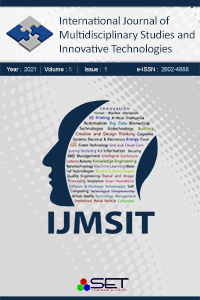Abstract
References
- [1] Columbia CTL. (n.d.). Active learning for your online classroom: five strategies using Zoom. https://ctl.columbia.edu/resources-and-technology/teaching-with-technology/teaching-online/active-learning/
- [2] Daniel, L., Visvizi, A., Gutiérrez-Braojos, C., & Lytras, M. D. (2018). Sustainable higher education and technology-enhanced learning (TEL) Sustainability, 2018(10), 3883-3905. doi:10.3390/su10113883.
- [3] Dunn, T. J., & Kennedy, M. (2019). Technology-enhanced learning in higher education: Motivations, engagement, and academic achievement. Computers & Education, 137,104-113. https://www.sciencedirect.com/science/article/abs/pii/S0360131519300831
- [4] Flavin, M., & Quintero, V. (2018). UK higher education institutions’ technology-enhanced learning strategies from the perspective of disruptive innovation. Research in Learning Technology, 26, 1-12. https://dx.doi.org/10.25304/rlt.v26.1987.
- [5] Hadi, R., & Valenzuela, A. (2019). Good vibrations: Consumer responses to technology-mediated haptic feedback. Marketing Science Institute Working Paper Series 2019, Report No. 19-116. https://www.msi.org/wp-content/uploads/2020/06/MSI_Report_19-116-1.pdf
- [6] Howles, D. (2015). Design tips for flipping the virtual classroom. Learning Solutions. https://learningsolutionsmag.com/articles/1721/design-tips-for-flipping-the-virtual-classroom
- [7] Kuppusamy, P. (2019). Smart education using Internet of Things technology. In: Emerging Technologies and Applications in Data Processing and Management, 385-412. Hershey, PA: IGI Global. DOI: 10.4018/978-1-5225-8446-9.ch017
- [8] Loveridge, S. (2020). What is haptic feedback and how will it change the way we play? Games Radar. https://www.gamesradar.com/haptic-feedback-explained/
- [9] Scanlon, E., & Conole, G. (2018). Interdisciplinarity in technology-enhanced learning: An interview study. Journal of Interactive Media in Education, 2018(1), 11-19. http://oro.open.ac.uk/57252/1/ES%20JIME%202018.pdf
- [10] Software Testing Help. (2020). 18 most popular IoT devices in 2020 (only noteworthy IoT products). https://www.softwaretestinghelp.com/iot-devices/
- [11] TEAME. (n.d.). Benefits of e-assessment. http://www.teame.ie/benefits-of-e-assessment/#:~:text=E-assessment%20is%20a%20valuable%20tool%20in%20Higher%20Education,many%20advantages%20over%20traditional%20pen%20and%20paper%20exams.
- [12] Thanaraj, A., & Williams, S. (2016). Supporting the adoption of technology-enhanced learning by academics at universities. Journal of Teaching and Learning with Technology, 5(1), 59-86. doi: 10.14434/jotlt.v5n1.18985
- [13] Zenios, M. (n.d.). Educational theory in technology enhanced learning (TEL) revisited: A model for simulation-based learning in higher education. British Journal of Educational Studies. https://www.researchgate.net/profile/Maria_Zenios/publication/342170201_Title_Educational_theory_in_technology_enhanced_learning_TEL_revisited_a_model_for_simulation-based_learning_in_higher_education/links/5ef46c8a92851c35353fca9.
Abstract
Abstract – Technology-enhanced learning (TEL) is rapidly becoming relevant for its ability to incorporate new and emerging technologies into education that can promote better learning, circumvent issues in traditional classroom environments, and engage learners more effectively. This paper provides an introduction and background to TEL, explains several theories that undergird the use of TEL, provides a literature review that examines TEL in several contexts, describes the methods used for the study, and details the results obtained. From a theoretical standpoint, TEL is primarily associated with disruptive innovation, because it changes the way things are done. Multidisciplinary as a component of activity theory is another salient feature of TEL and situated learning theory is used to explain why haptic feedback improves TEL effectiveness. The literature review discusses different aspects of TEL that have been studied, and the methods section describes how the data was collected and analyzed. The research findings and recommendations are based on the data collected through online survey and its analysis. The data used in this research is mostly primary. The participants were from Kuwait and the recommendations are suitable for Kuwait Technological learning environment. One of the important findings of the research was that participants agreed that big data is influencing the educational sector due to the sudden shift to online teaching and is creating a common use experience for everyone who is part of it. Another important research was that most of the educators feel that TEL supports the individual growth of a learner. In addition, educators believe that TEL will be more effective if senior management supports them and there is a TEL support center to assist when needed. The current situation that we are facing because of COVID-19 has given TEL a strong foundation as educators are using it like never before. This has also enabled the TEL to grow and adopt to new situations and teaching environments..
References
- [1] Columbia CTL. (n.d.). Active learning for your online classroom: five strategies using Zoom. https://ctl.columbia.edu/resources-and-technology/teaching-with-technology/teaching-online/active-learning/
- [2] Daniel, L., Visvizi, A., Gutiérrez-Braojos, C., & Lytras, M. D. (2018). Sustainable higher education and technology-enhanced learning (TEL) Sustainability, 2018(10), 3883-3905. doi:10.3390/su10113883.
- [3] Dunn, T. J., & Kennedy, M. (2019). Technology-enhanced learning in higher education: Motivations, engagement, and academic achievement. Computers & Education, 137,104-113. https://www.sciencedirect.com/science/article/abs/pii/S0360131519300831
- [4] Flavin, M., & Quintero, V. (2018). UK higher education institutions’ technology-enhanced learning strategies from the perspective of disruptive innovation. Research in Learning Technology, 26, 1-12. https://dx.doi.org/10.25304/rlt.v26.1987.
- [5] Hadi, R., & Valenzuela, A. (2019). Good vibrations: Consumer responses to technology-mediated haptic feedback. Marketing Science Institute Working Paper Series 2019, Report No. 19-116. https://www.msi.org/wp-content/uploads/2020/06/MSI_Report_19-116-1.pdf
- [6] Howles, D. (2015). Design tips for flipping the virtual classroom. Learning Solutions. https://learningsolutionsmag.com/articles/1721/design-tips-for-flipping-the-virtual-classroom
- [7] Kuppusamy, P. (2019). Smart education using Internet of Things technology. In: Emerging Technologies and Applications in Data Processing and Management, 385-412. Hershey, PA: IGI Global. DOI: 10.4018/978-1-5225-8446-9.ch017
- [8] Loveridge, S. (2020). What is haptic feedback and how will it change the way we play? Games Radar. https://www.gamesradar.com/haptic-feedback-explained/
- [9] Scanlon, E., & Conole, G. (2018). Interdisciplinarity in technology-enhanced learning: An interview study. Journal of Interactive Media in Education, 2018(1), 11-19. http://oro.open.ac.uk/57252/1/ES%20JIME%202018.pdf
- [10] Software Testing Help. (2020). 18 most popular IoT devices in 2020 (only noteworthy IoT products). https://www.softwaretestinghelp.com/iot-devices/
- [11] TEAME. (n.d.). Benefits of e-assessment. http://www.teame.ie/benefits-of-e-assessment/#:~:text=E-assessment%20is%20a%20valuable%20tool%20in%20Higher%20Education,many%20advantages%20over%20traditional%20pen%20and%20paper%20exams.
- [12] Thanaraj, A., & Williams, S. (2016). Supporting the adoption of technology-enhanced learning by academics at universities. Journal of Teaching and Learning with Technology, 5(1), 59-86. doi: 10.14434/jotlt.v5n1.18985
- [13] Zenios, M. (n.d.). Educational theory in technology enhanced learning (TEL) revisited: A model for simulation-based learning in higher education. British Journal of Educational Studies. https://www.researchgate.net/profile/Maria_Zenios/publication/342170201_Title_Educational_theory_in_technology_enhanced_learning_TEL_revisited_a_model_for_simulation-based_learning_in_higher_education/links/5ef46c8a92851c35353fca9.
Details
| Primary Language | English |
|---|---|
| Subjects | Engineering |
| Journal Section | Articles |
| Authors | |
| Publication Date | July 31, 2021 |
| Submission Date | May 23, 2021 |
| Published in Issue | Year 2021 Volume: 5 Issue: 1 |


